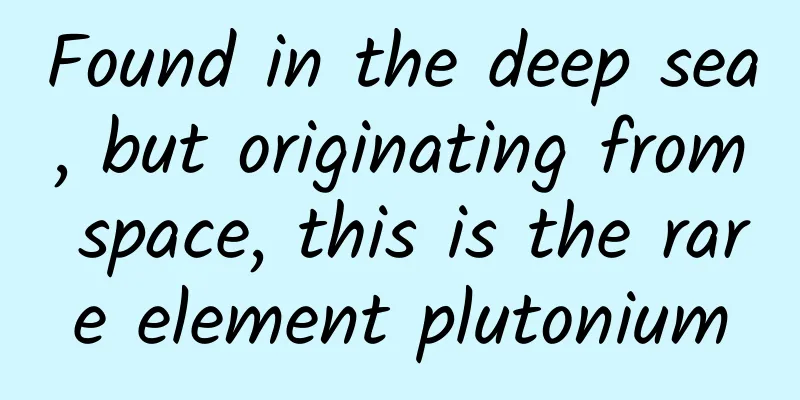Found in the deep sea, but originating from space, this is the rare element plutonium

|
By detecting plutonium-244, the heavy metal structure of a star can be determined. Image: SN2014J is the closest star to a supernova in the past 10 years. Research suggests that heavy metals in the universe are produced by the explosion of such stars. Scientists have detected the radioactive element plutonium in the deep ocean crust, a rare discovery that provides new clues to the makeup of heavy metals in unexplored stars. The isotope plutonium-244 may have appeared on Earth at the same time as the lighter metal iron-60 in supernovas, a study suggests. This suggests that supernovas may also produce heavy metals, although other events, such as neutron star mergers, may also form heavy metals like plutonium-244. Anton Werner, a nuclear physicist at the Australian National University and the Helmholtz-Zentrum Dresden-Rossendorf in Germany, said that untangling the formation mechanism of heavy metals remains one of the three major problems in physics. About 50% of the metals heavier than iron are formed in the cores of stars through nuclear fusion, while the remaining half require the help of high-density free neutrons. This means that the other half must be formed in an environment more explosive than the core of a supernova, such as a large event such as a neutron star merger or a black hole-neutron star collision. Werner is collaborating with scientists from China, Australia, and the United States in the hope of finding traces of celestial events that occurred on Earth. Already, they have discovered some radioactive heavy metal elements that have never formed naturally on Earth. Specifically, researchers are looking for plutonium-244, a variant of plutonium with a half-life of 80.6 million years, meaning it will take 80.6 million years of radioactive decay for plutonium-244 to consume half of the initial plutonium. Any plutonium-244 that was originally present during the formation of the Earth has decayed, so any atoms that researchers are able to find are early foreign matter. "Can we find plutonium-244 on Earth? Then, we'll know it came from space," Werner said. Rare Metals In order to find rare elements, researchers collected crustal samples located 5,000 feet (about 1,500 meters) below the Pacific Ocean. Werner told LIVE Science that these rocks were formed very slowly, and one millimeter of crust is about 400,000 years old. This sample collection covers crustal rocks from the past 10 million years or so. The researchers then examined the samples for the extraterrestrial iron elements iron-60 and plutonium-244, which are formed in supernovae. They found both. Werner said that the discovery of iron-60 was not surprising, as previous studies had already found fluctuations in iron-60 in deep-sea sediments and the Earth's crust. This discovery confirms the researchers' previous hypothesis that iron-60 had two growth periods, one between 4.2 million and 55 million years ago and another seven million years ago. The fluctuations in this metal element may have been affected by two nearby supernovae. "It would have been a very spectacular supernova," Werner said. "That's when the iron-60 is produced. It would have been as bright as a full moon, so you would have probably been able to see it even during the day." In the past, researchers lacked sensitive enough detection equipment to accurately detect the extremely rare metal element plutonium-244 scattered on the Earth's crust. However, with the help of cutting-edge technology and methods, the current research has been able to do so. Because researchers must sort out the crust layer from 3 million to 5 million years ago, it is still difficult to determine the time point when this extraterrestrial plutonium element arrived on Earth, but it can be found that the fluctuation level of plutonium-244 is correlated with the fluctuation level of iron-60. "The ratio of plutonium-244 to iron-60 seems to be constant," said Werner, indicating that the two may come from the same source. Forged in the Stars Although both plutonium-244 and iron-60 may have come from supernovae, there are still many questions to be answered. Werner said that computational models try to simulate the process of element formation inside supernovae, but in reality it is difficult to produce heavy elements. The ratio of plutonium-244 to iron-60 found in the latest study shows that the content of plutonium-244 is much lower than that of iron-60 after the explosion of the star, and plutonium-244 may only account for a small part of the total amount of elements. Werner pointed out that there is also a possibility that the plutonium-244 found in the deep sea crust did not come from supernovas. It may also be formed in an earlier celestial event and randomly scattered in deep space. When it encounters iron-60, plutonium-244 is attracted by its heavier mass and then combines with iron-60. In this case, the two elements will arrive on Earth at the same time, but the plutonium-244 will be formed relatively earlier. To explore this possibility, the researchers hope to further study atoms with different half-life cycles. The half-life cycle is like a clock that allows scientists to determine the range of an element's life cycle. For example, if plutonium-244 is found at the same time as another element with a shorter half-life cycle, then this means that both are younger elements. At the same time, this also shows that the plutonium-244 produced in supernovas is very low in content, and most of the plutonium-244 is born from other events such as neutron star mergers. The research team is currently studying a crust sample 10 times larger. Studying a larger crust sample will help researchers expand the range of the search for plutonium-244 and more accurately determine when plutonium-244 arrived on Earth. “The most amazing thing about this process is that you end up finding that the six or 10 elements you find are not from Earth but from space, and then you get some clues about where they came from and when they were formed,” Werner said. BY: Stephanie Pappas FY: Autumn If there is any infringement of related content, please contact the author to delete it after the work is published. Please obtain authorization for reprinting, and pay attention to maintaining integrity and indicating the source |
<<: Chang'e-5 lunar soil reveals a big mystery!
Recommend
Living fossils in the deep sea, hidden miracles of golden geometry?
Nautilus is a general term for marine molluscs in...
The "fission" battle between Luckin Coffee and Lian Coffee: Who is the growth king?
Two years ago, when people talked about drinking ...
The most comprehensive guide to Kuaishou information flow advertising is online
Kuaishou is a well-known short video application ...
"Nezha 2" has exceeded 10 billion box office! These three types of people are not recommended to watch the 3D version
Review expert: Peng Guoqiu, deputy chief physicia...
Marketing: Apple says no one dares to be number one?
John Sculley, this seemingly unfamiliar name, act...
Ctrip's exploration and practice of physical linking technology
Author|Ctrip Travel AI R&D team is committed...
High Entropy Alloys: New Materials Developed from “Chemical Disorder”
Recently, the article "Liquid Metal for the ...
30 Unforgettable HTML 5 Templates
In today's world, content management systems ...
Are you really not fat? Is it possible that you are an "invisible fat person"?
Statement: This article is a medical-related educ...
How to quickly build a marketing and promotion system for 2B products
In the past two years, the SAAS product market ha...
Playing with Douyin, from 0 to 1, from attracting fans to making money...
“ Tik Tok in the south, Kuaishou in the north”! W...
Google Now update: Can be used without network
As Google continues to strengthen Google Now, Goog...
2019 Internet Marketing Promotion Tips!
With the gradual improvement of current Internet ...
How to create a hot-selling fission event promotion?
Fission is an important part of studying user gro...









